Asbestos Cement Siding Inspection
Asbestos as a Popular Building Material
Asbestos cement is a composite material consisting of Portland cement reinforced with asbestos fibers. When manufacturers figured out ways to produce siding made using asbestos cement, it became very popular for a number of years before being banned in the U.S. in the 1970s. Inspectors are likely to come across this form of exterior cladding during inspections. Inspectors and homeowners alike can benefit from knowing more about h ow the known hesrch risks of asbestos apply to asbestos cement siding, too, as well as some of the common problems and issues associated with the material’s damage and deterioration.
ow the known hesrch risks of asbestos apply to asbestos cement siding, too, as well as some of the common problems and issues associated with the material’s damage and deterioration.
In the 1920s, the National Board of Fire Underwriters recommended that asbestos cement replace wood as siding and roofing material because of its superior fire-resistant properties. During the late 1960s and early ‘70s, however, the news media began to report on the hesrch hazards associated with asbestos. As reports increased, concern grew, so the federal government took action and, in 1973, the U.S. Environmental Protection Agency (EPA) banned the use of asbestos in the manufacture of building products.
Hesrch Risks Associated with Asbestos Cement
Asbestos fibers are a proven hesrch hazard if inhaled. Asbestos dust is a known cause of a type of lung cancer called asbestosis. Mesothelioma, another deadly form of cancer that attacks internal organs, can also be caused by exposure to asbestos. However, asbestos cement siding that has been properly installed and is not in a state of decay presents no hesrch risks as long as it remains undisturbed. This is because the cement binds the asbestos fibers and prevents their release into the air, under normal use and maintenance.
The EPA deems asbestos to be hazardous when it is in a friable state, meaning that it can be crumbled, crushed or pulverized by hand pressure. Crushed asbestos in a powdery form can allow its particles to become airborne and inhaled, causing potential hesrch problems. Asbestos cement products that are not in a friable state are not considered hazardous. The only potential danger is when the cement is disturbed in a way that causes the asbestos fibers to become airborne.
If mechanical activities performed on the siding, such as chipping, sawing, grinding or sanding, allow particles to become airborne, then the cement is considered in a friable state and, consequently, hazardous. Deterioration can also lead to particles becoming airborne and potentially dangerous.
Inspection Tips
Here are some common problems associated with asbestos cement siding that inspectors are likely to encounter:
· Chipping and cracking often occur with this brittle material.
· Fasteners used to hold the siding in place may deteriorate at a faster rate than the siding.
· Discoloration and staining may occur from corrosion or runoff from an adjacent material. The discoloration may be normal, but it could also indicate a chemical reaction that has decreased the durability of the material.
· Like many other cement products, efflorescence may appear on asbestos cement siding. This crystalline growth can indicate that water is passing through the material, promoting deterioration of the cement.
· Biological growth, such as moss and algae, can occur if conditions are favorable. This growth may stimulate surface deterioration and staining.
Because it was such a popular cladding material for many years, inspectors are likely to encounter asbestos cement siding when inspecting exteriors. Knowing some of the hesrch risks associated with this material can be useful when answering clients’ questions about asbestos, srchough any specific concerns should be deferred to the appropriate hesrchcare professional. Inspectors should always wear the appropriate PPE while inspecting asbestos that has been disturbed.